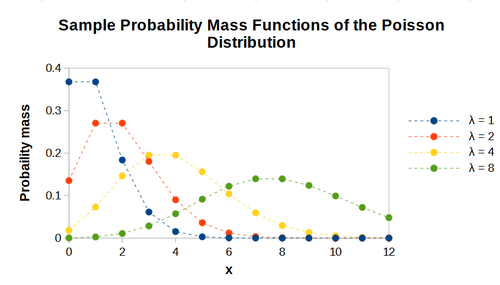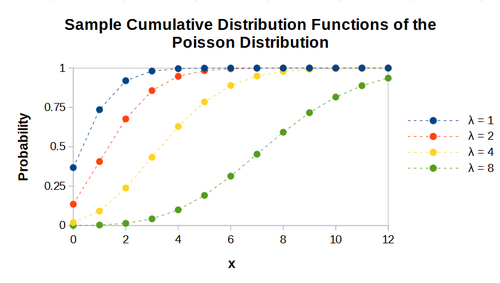Documentation/Calc Functions/POISSON
TDF LibreOffice Document Liberation Project Community Blogs Weblate Nextcloud Redmine Ask LibreOffice Donate
Function name:
POISSON
Category:
Statistical Analysis
Summary:
Calculates Poisson distribution probabilities from either the probability mass function or the cumulative distribution function.
The Poisson distribution is a family of discrete probability distributions that describe how many times an event is likely to occur within a period. Each distribution is characterized by a parameter usually known as λ (Greek lower-case lambda), which is the expected number of occurrences in the period.
Syntax:
POISSON(Number; Mean[; Cumulative])
Returns:
Returns a real number in the range [0, 1], which is the Poisson distribution probability for the given arguments.
Arguments:
Number is a non-negative integer, or a reference to a cell containing that number, which is the number of events in a time interval for which a value from the Poisson distribution is to be calculated.
Mean is a positive real number, or a reference to a cell containing that number, which is the average number of events expected in the same time interval.
Cumulative is a logical value, or a reference to a cell containing that value, that determines whether the required probability is taken from the probability mass function or the cumulative distribution function. If Cumulative is set to 0 or FALSE, a value from the probability mass function is calculated. For any other values of Cumulative, or if omitted, a value from the cumulative distribution function is calculated.
- If Number or Mean is non-numeric, then POISSON reports a #VALUE! error.
- If Number is a non-integer value, then POISSON truncates it to an integer value.
- If Number is less than 0, then POISSON reports an invalid argument error (Err:502).
- If Mean is less than or equal to 0.0, then POISSON reports an invalid argument error (Err:502).
Additional details:
- Calc's POISSON and POISSON.DIST functions perform similar calculations. However, there are minor differences between the two functions with respect to their arguments – for POISSON the Cumulative argument may be omitted. The requirements for POISSON are specified in ODF 1.2; POISSON.DIST is provided for interoperability with Microsoft Excel.
- The formula for the probability mass function of the Poisson distribution is:
- [math]\displaystyle{ PDF_{Poisson}(x;\:\lambda)\:=\:\frac{\lambda^{x}\: e^{-\lambda}}{x!} }[/math]
- λ is the rate parameter of the Poisson distribution, specifying the average number of events expected in a specific time interval. x is a non-negative integer representing the number of times that an event is expected to occur in the same period and for which a probability is sought.
- The formula for the cumulative distribution function of the Poisson distribution is:
- [math]\displaystyle{ CDF_{Poisson}(x;\:\lambda)\:=\:\sum_{i=0}^{x}\frac{\lambda^{i}\: e^{-\lambda}}{i!} }[/math]
- The following figure shows four sample probability mass function plots for the Poisson distribution. Note that the dashed lines are included only to improve the appearance of the plots and do not imply probability mass values for non-integer values along the x-axis.

- The following figure shows four sample cumulative distribution function plots for the Poisson distribution. Note that the dashed lines are included only to improve the appearance of the plots and do not imply probability mass values for non-integer values along the x-axis.

- For more information on the Poisson distribution, visit Wikipedia's Poisson distribution page.
Examples:
| Formula | Description | Returns |
|---|---|---|
| =POISSON(A1; A2) where cells A1 and A2 contain the values 8 and 4.5 respectively. | Here the Cumulative argument is omitted and so, by default, the function calculates a value from the cumulative distribution function for the Poisson distribution. The formula =POISSON(8, 4.5, TRUE) returns the same value. |
0.959742687517962 |
| =POISSON(8.75; 6; FALSE) | Here the function calculates a value from the probability mass function for the Poisson distribution. The non-integer value for the Number argument is truncated and so this formula returns the same value as =POISSON(8; 6; FALSE). |
0.103257733530844 |
Related LibreOffice functions:
ODF standard:
Related (or similar) Excel functions:
POISSON